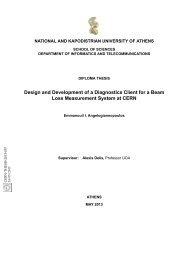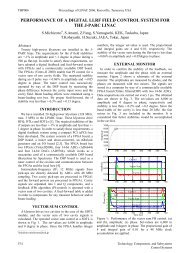Masked strips in reconstruction
Masked strips in reconstruction
Masked strips in reconstruction
You also want an ePaper? Increase the reach of your titles
YUMPU automatically turns print PDFs into web optimized ePapers that Google loves.
RPCDPG Latest Results<br />
Camilo Carrillo<br />
on behalf of<br />
RPC Trigger Group.<br />
Departamento de Física<br />
UNIVERSIDAD DE LOS ANDES<br />
Bogotá, Colombia<br />
CMS Week, September 2008<br />
Muon DPGPOG Meet<strong>in</strong>g
• RPC System.<br />
Outl<strong>in</strong>e<br />
• Synchronization status.<br />
• RPC Noise studies.<br />
• RPC Efficiency.<br />
• Simulation / Reclusterization.<br />
• Conclusions
Full barrel and positive endcap (RE+1 & RE+3 ) <strong>in</strong> read out<br />
Occupancy plots (from DQM):<br />
RPC System<br />
One noisy chamber <strong>in</strong> this sector.<br />
10/12 trigger crate <strong>in</strong> operation: power supplies miss<strong>in</strong>g.
Gas system stable : fresh <strong>in</strong>jection about 10 %<br />
Current monitor of one chamber<br />
over one month<br />
RPC Gas<br />
Purifiers: automatic change over takes place without problem<br />
Gas Flow (<strong>in</strong> and out ) monitor of<br />
one channel over one month<br />
Analysis module (O 2+H 2O): gas mixture is automatically analyz<strong>in</strong>g before and after<br />
the purifiers.<br />
Gas chromatograph work<strong>in</strong>g f<strong>in</strong>e (at the moment it is <strong>in</strong> reparation)
Synchronization
Synchronization
Noise Studies<br />
A tool for identification of noisy <strong>strips</strong> <strong>in</strong> a<br />
given chamber.
RPC Efficiency Segment<br />
Same wheel and Same Sector.<br />
For RB1, we extrapolate from MB1<br />
For RB2 we extrapolate from MB2<br />
For RB3 we extrapolate from MB3<br />
For RB4 we extrapolate from MB3<br />
and MB4<br />
Extrapolation.<br />
DT CSC<br />
All DT Chambers.<br />
For RPCs <strong>in</strong> R<strong>in</strong>g 2 we extrapolate from<br />
Same R<strong>in</strong>g and Same Station (Disk) of<br />
CSCs.<br />
For RPCs <strong>in</strong> R<strong>in</strong>g 3 we extrapolate from<br />
Same Station (Disk) but always R<strong>in</strong>g 2<br />
of CSCs<br />
We don't use Station 4 nor R<strong>in</strong>g 1 of CSCs
Run 58555<br />
Event 5708904
Other view for the same Event
HV Scan with DT Segment<br />
Extrapolation
HV Scan for W+1 Near Side<br />
(Average Efficiency)
Simulation<br />
The RPC simulation, s<strong>in</strong>ce may, has reached the maximum<br />
level of the details concern<strong>in</strong>g noise and efficiency.<br />
Maps conta<strong>in</strong><strong>in</strong>g the <strong>in</strong>formations concern<strong>in</strong>g the noise and<br />
efficiency, strip by strip, can be loaded and used to digitize<br />
the simulated hits. An object <strong>in</strong> ORCOFF is stored<br />
permanently with a proper IOV.<br />
Therefore <strong>in</strong> pr<strong>in</strong>ciple the simulation could be always<br />
upgraded with the results com<strong>in</strong>g from the prompt analysis.<br />
This will become a standard procedure when the efficiency<br />
will be estimated. In order to perform this upgrade the<br />
simulation package need only the new files uploaded <strong>in</strong><br />
ORCOFF.
Simulation<br />
• The previous way to run the simulation (read<strong>in</strong>g from<br />
ORCOFF) allows to get results comparable with the real<br />
situation.<br />
• However it didn’t allow to perform any forecast about the<br />
<strong>in</strong>fluence of different parameter detectors on the L1 RPC<br />
trigger performance.<br />
• Files similar to the ones stored <strong>in</strong> ORCOFF are available to the<br />
user, <strong>in</strong> order to change values of noise and efficiency of the<br />
conditions <strong>in</strong> the wished way.<br />
• This is crucial for the next complete study of the RPC Trigger<br />
performance <strong>in</strong> the Barrel, but specially <strong>in</strong> the Forward part, <strong>in</strong><br />
order to understand the effect of noise.
RECLUSTERIZATION<br />
• At the moment no <strong>in</strong>formation about noise is stored <strong>in</strong><br />
the ORCON/ORCOFF data bases.<br />
• In particular, there is no <strong>in</strong>formation about noisy <strong>strips</strong><br />
that are masked.<br />
• Currently the maskedstrip <strong>in</strong>formation is not used <strong>in</strong><br />
<strong>reconstruction</strong>.<br />
• The software to take masked <strong>strips</strong> <strong>in</strong>to account is be<strong>in</strong>g<br />
produced.
<strong>Masked</strong>strip <strong>in</strong>formation<br />
• The maskedstrip <strong>in</strong>formation should be <strong>in</strong> the ORCOFF<br />
data base <strong>in</strong> the future . In order to do this a payload<br />
application is needed.<br />
• In the meanwhile it will use only the fake condition stored<br />
by means of dat file <strong>in</strong> the package<br />
Calibration/RPCCalibration. A file called<br />
RPC<strong>Masked</strong>Strips.dat.<br />
• The file will conta<strong>in</strong> for each RPC roll: the RPCDetId, the<br />
raw Id, and a list of 96 bits (“0” or “1”).<br />
• The file is read out <strong>in</strong> the constructor of the<br />
RPCRecHitProducer class and stored <strong>in</strong> an RPCDetId<br />
→ RollMask map
Mask reclusterization<br />
• Until now If there is a masked strip between two clusters,<br />
the two clusters rema<strong>in</strong> separate.<br />
• For the clusterization process it will be assumed that the<br />
masked strip between two clusters had a hit, and the two<br />
clusters will be merged.<br />
• The software should look for clusters separated by a<br />
masked strip, and merge them.
Mask reclusterization<br />
implementation<br />
• A new class called RPCMaskReClusterizer has been<br />
created <strong>in</strong>side the RecoLocalMuon/RPCRecHit package:<br />
const <strong>in</strong>t SIZE=96;<br />
typedef std::bitset RollMask;<br />
class RPCMaskReClusterizer<br />
{<br />
public :<br />
};<br />
RPCMaskReClusterizer();<br />
~RPCMaskReClusterizer();<br />
RPCClusterConta<strong>in</strong>er doAction(const RPCDetId& ,RPCClusterConta<strong>in</strong>er& , const RollMask& );<br />
<strong>in</strong>t get(const RollMask& ,<strong>in</strong>t );
Reclusterization procedure<br />
• The exist<strong>in</strong>g Clusterizer <strong>in</strong> the RPCRecHit package<br />
produces a cluster conta<strong>in</strong>er out of an<br />
RPCDigiCollection.<br />
• The ReClusterizer takes that cluster conta<strong>in</strong>er and<br />
produces a new cluster conta<strong>in</strong>er after reclusterization.<br />
• The ReClusterization algorithm is identical to the<br />
Clusterization one, only the condition for merg<strong>in</strong>g<br />
clusters changes from:<br />
Adjacent clusters<br />
→<br />
A masked strip between two clusters
Conclusions<br />
� The RPC system for the Barrel, RE+1 and<br />
RE+3 are <strong>in</strong> readouts.<br />
� RPC Gas System work<strong>in</strong>g <strong>in</strong> closed loop,<br />
10% of fresh <strong>in</strong>jection.<br />
� Tools for monitor<strong>in</strong>g up to <strong>strips</strong> level<br />
(maximum granularity level) efficiency and<br />
noise have been developed.
Conclusions<br />
• More realistic simulations are com<strong>in</strong>g<br />
tak<strong>in</strong>g <strong>in</strong>to account the parameters of the<br />
detector.<br />
• Improvements about the reconstructed<br />
RPC Hits are under construction.<br />
• HV Scan done for the near side <strong>in</strong> the<br />
Barrel.<br />
• RPC Efficiency tool look<strong>in</strong>g forward for<br />
collisions.















